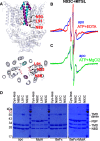EPR spectroscopy of MolB2C2-a reveals mechanism of transport for a bacterial type II molybdate importer
- PMID: 23709218
- PMCID: PMC3774390
- DOI: 10.1074/jbc.M113.483495
EPR spectroscopy of MolB2C2-a reveals mechanism of transport for a bacterial type II molybdate importer
Abstract
In bacteria, ATP-binding cassette (ABC) transporters are vital for the uptake of nutrients and cofactors. Based on differences in structure and activity, ABC importers are divided into two types. Type I transporters have been well studied and employ a tightly regulated alternating access mechanism. Less is known about Type II importers, but much of what we do know has been observed in studies of the vitamin B12 importer BtuC2D2. MolB2C2 (formally known as HI1470/71) is also a Type II importer, but its substrate, molybdate, is ∼10-fold smaller than vitamin B12. To understand mechanistic differences among Type II importers, we focused our studies on MolBC, for which alternative conformations may be required to transport its relatively small substrate. To investigate the mechanism of MolBC, we employed disulfide cross-linking and EPR spectroscopy. From these studies, we found that nucleotide binding is coupled to a conformational shift at the periplasmic gate. Unlike the larger conformational changes in BtuCD-F, this shift in MolBC-A is akin to unlocking a swinging door: allowing just enough space for molybdate to slip into the cell. The lower cytoplasmic gate, identified in BtuCD-F as "gate I," remains open throughout the MolBC-A mechanism, and cytoplasmic gate II closes in the presence of nucleotide. Combining our results, we propose a peristaltic mechanism for MolBC-A, which gives new insight in the transport of small substrates by a Type II importer.
Keywords: ABC Transporter; Electron Paramagnetic Resonance (EPR); Importer; Membrane Proteins; Molybdate; Protein Conformation; Protein Dynamics.
Figures






Similar articles
-
Small substrate transport and mechanism of a molybdate ATP binding cassette transporter in a lipid environment.J Biol Chem. 2014 May 23;289(21):15005-13. doi: 10.1074/jbc.M114.563783. Epub 2014 Apr 10. J Biol Chem. 2014. PMID: 24722984 Free PMC article.
-
Distinct gate conformations of the ABC transporter BtuCD revealed by electron spin resonance spectroscopy and chemical cross-linking.FEBS Lett. 2009 Jan 22;583(2):266-70. doi: 10.1016/j.febslet.2008.12.020. Epub 2008 Dec 25. FEBS Lett. 2009. PMID: 19101549
-
Transmembrane gate movements in the type II ATP-binding cassette (ABC) importer BtuCD-F during nucleotide cycle.J Biol Chem. 2011 Nov 25;286(47):41008-17. doi: 10.1074/jbc.M111.269472. Epub 2011 Sep 27. J Biol Chem. 2011. PMID: 21953468 Free PMC article.
-
Tripartite ATP-Independent Periplasmic (TRAP) Transporters and Tripartite Tricarboxylate Transporters (TTT): From Uptake to Pathogenicity.Front Cell Infect Microbiol. 2018 Feb 12;8:33. doi: 10.3389/fcimb.2018.00033. eCollection 2018. Front Cell Infect Microbiol. 2018. PMID: 29479520 Free PMC article. Review.
-
Tripartite transporters as mechanotransmitters in periplasmic alternating-access mechanisms.FEBS Lett. 2020 Dec;594(23):3908-3919. doi: 10.1002/1873-3468.13929. Epub 2020 Oct 4. FEBS Lett. 2020. PMID: 32936941 Review.
Cited by
-
Signal Transduction by BvgS Sensor Kinase: BINDING OF MODULATOR NICOTINATE AFFECTS THE CONFORMATION AND DYNAMICS OF THE ENTIRE PERIPLASMIC MOIETY.J Biol Chem. 2015 Sep 18;290(38):23307-19. doi: 10.1074/jbc.M115.655720. Epub 2015 Jul 22. J Biol Chem. 2015. PMID: 26203186 Free PMC article.
-
Effects of lipid environment on the conformational changes of an ABC importer.Channels (Austin). 2014;8(4):327-33. doi: 10.4161/chan.29294. Channels (Austin). 2014. PMID: 24852576 Free PMC article.
-
Diversity in ABC transporters: type I, II and III importers.Crit Rev Biochem Mol Biol. 2014 Sep-Oct;49(5):426-37. doi: 10.3109/10409238.2014.953626. Epub 2014 Aug 26. Crit Rev Biochem Mol Biol. 2014. PMID: 25155087 Free PMC article. Review.
-
ATP Hydrolysis Induced Conformational Changes in the Vitamin B12 Transporter BtuCD Revealed by MD Simulations.PLoS One. 2016 Nov 21;11(11):e0166980. doi: 10.1371/journal.pone.0166980. eCollection 2016. PLoS One. 2016. PMID: 27870912 Free PMC article.
-
ATP binding and hydrolysis disrupt the high-affinity interaction between the heme ABC transporter HmuUV and its cognate substrate-binding protein.J Biol Chem. 2017 Sep 1;292(35):14617-14624. doi: 10.1074/jbc.M117.779975. Epub 2017 Jul 14. J Biol Chem. 2017. PMID: 28710276 Free PMC article.
References
-
- Holland I. B. (2003) ABC Proteins: From Bacteria to Man, 1st Ed., Academic Press, San Diego, CA
-
- Wang B., Dukarevich M., Sun E. I., Yen M. R., Saier M. H. (2009) Membrane porters of ATP-binding cassette transport systems are polyphyletic. J. Membr. Biol. 231, 1–10 - PubMed
-
- Ernst R., Kueppers P., Stindt J., Kuchler K., Schmitt L. (2010) Multidrug efflux pumps: substrate selection in ATP-binding cassette multidrug efflux pumps–first come, first served? FEBS J. 277, 540–549 - PubMed
-
- Dean M., Hamon Y., Chimini G. (2001) The human ATP-binding cassette (ABC) transporter superfamily. J. Lipid Res. 42, 1007–1017 - PubMed
Publication types
MeSH terms
Substances
Grants and funding
LinkOut - more resources
Full Text Sources
Other Literature Sources

